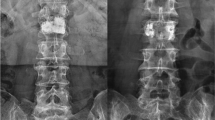Abstract
Purpose
To evaluate the benefits of minimally invasive balloon kyphoplasty (BKP) in patients with cancer and painful pathologic vertebral lesions.
Methods
In this longitudinal, prospective, consecutive study, patients received BKP at one or more vertebral levels. The BKP procedure was guided by computed tomographic fluoroscopy. Orthopaedic bone tamps were inflated to create a cavity and the fracture was stabilised using viscous polymethylmethacrylate bone cement. After the procedure, early mobilisation was encouraged.
Results
Overall, 115 patients (52.2 % with vertebral fractures) received BKP. The majority (82.6 %) of patients received BKP as a stand-alone procedure. BKP treatment provided significant (P < 0.0001) improvements in Visual Analogue Scale (VAS)-pain (median change: −4), Oswestry Disability Index (ODI; mean change: −53.2), and Karnofsky Performance Status (KPS; median change: 15) scores at 6 and 12 months. In total, 23 % of patients achieved increased vertebral height (7.4 % mean improvement in angle index). The presence of height restoration and the number of levels treated did not affect VAS or ODI scores; improvements in KPS scores were numerically higher in patients who received BKP plus additional surgery (15–20) compared with stand-alone BKP (10–15). Mean hospital times were 7.2 ± 6.5 days. The majority (97.4 %) of patients showed no complications related to the procedure; three patients (2.6 %) had a temporary radiculopathy. Incidences of cement leakage were observed in 40 patients (34.8 %).
Conclusions
Minimally invasive BKP provided excellent long-term palliation of pain and improved mobility in patients with cancer and painful osteolytic spinal lesions or vertebral fractures.



Similar content being viewed by others
References
Coleman RE (2006) Clinical features of metastatic bone disease and risk of skeletal morbidity. Clin Cancer Res 12(20 Pt 2):6243s–6249s
Costa L, Badia X, Chow E, Lipton A, Wardley A (2008) Impact of skeletal complications on patients’ quality of life, mobility, and functional independence. Support Care Cancer 16(8):879–889
Melton LJ III, Kyle RA, Achenbach SJ, Oberg AL, Rajkumar SV (2005) Fracture risk with multiple myeloma: a population-based study. J Bone Miner Res 20(3):487–493
Kanis JA, McCloskey EV (1997) Bone turnover and biochemical markers in malignancy. Cancer 80(8 Suppl):1538–1545
Mosekilde L (1993) Vertebral structure and strength in vivo and in vitro. Calcif Tissue Int 53(Suppl 1):S121–S125
Lieberman I, Reinhardt MK (2003) Vertebroplasty and kyphoplasty for osteolytic vertebral collapse. Clin Orthop Relat Res 415(Suppl):S176–S186
Lieberman IH, Dudeney S, Reinhardt MK, Bell G (2001) Initial outcome and efficacy of “kyphoplasty” in the treatment of painful osteoporotic vertebral compression fractures. Spine (Phila Pa 1976) 26(14):1631–1638
Dudeney S, Lieberman IH, Reinhardt MK, Hussein M (2002) Kyphoplasty in the treatment of osteolytic vertebral compression fractures as a result of multiple myeloma. J Clin Oncol 20(9):2382–2387
Köse KC, Cebesoy O, Akan B, Altinel L, Dinçer D, Yazar T (2006) Functional results of vertebral augmentation techniques in pathological vertebral fractures of myelomatous patients. J Natl Med Assoc 98(10):1654–1658
Fourney DR, Schomer DF, Nader R et al (2003) Percutaneous vertebroplasty and kyphoplasty for painful vertebral body fractures in cancer patients. J Neurosurg 98(1 Suppl):21–30
Pflugmacher R, Taylor R, Agarwal A et al (2008) Balloon kyphoplasty in the treatment of metastatic disease of the spine: a 2-year prospective evaluation. Eur Spine J 17(8):1042–1048
König MA, Jehan S, Balamurali G, Bierschneider M, Grillhösl A, Boszczyk BM (2012) Kyphoplasty for lytic tumour lesions of the spine: prospective follow-up of 11 cases from procedure to death. Eur Spine J 21:1873–1879
Taneichi H, Kaneda K, Takeda N, Abumi K, Satoh S (1997) Risk factors and probability of vertebral body collapse in metastasis of the thoracic and lumbar spine. Spine 22(3):239–245
Tokuhashi Y, Matsuzaki H, Oda H, Oshima M, Ryu J (2005) A revised scoring system for preoperative evaluation of metastatic spine tumor prognosis. Spine 30(19):2186–2191
Bouza C, Lopez-Cuadrado T, Cediel P, Saz-Parkinson Z, Amate JM (2009) Balloon kyphoplasty in malignant spinal fractures: a systematic review and meta-analysis. BMC Palliat Care 8:12
Berenson J, Pflugmacher R, Jarzem P et al (2011) Balloon kyphoplasty versus non-surgical fracture management for treatment of painful vertebral body compression fractures in patients with cancer: a multicentre, randomised controlled trial. Lancet Oncol 12(3):225–235
Acknowledgments
The author would like to thank Dr Maria Efstathiou (Quintiles Biostatistics) for performing the statistical analysis and Dr Richard Barry (Quintiles Medical Communications) for medical writing assistance, which were both funded by Medtronic.
Conflict of interest
None.
Author information
Authors and Affiliations
Corresponding author
Rights and permissions
About this article
Cite this article
Markmiller, M. Percutaneous balloon kyphoplasty of malignant lesions of the spine: a prospective consecutive study in 115 patients. Eur Spine J 24, 2165–2172 (2015). https://doi.org/10.1007/s00586-014-3751-7
Received:
Revised:
Accepted:
Published:
Issue Date:
DOI: https://doi.org/10.1007/s00586-014-3751-7




